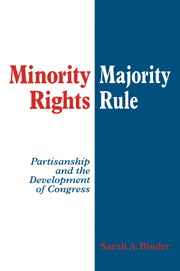
-
Select format
-
- Publisher:
- Cambridge University Press
- Publication date:
- 10 December 2009
- 13 June 1997
- ISBN:
- 9780511625541
- 9780521582391
- 9780521587921
- Dimensions:
- (228 x 152 mm)
- Weight & Pages:
- 0.535kg, 256 Pages
- Dimensions:
- (228 x 152 mm)
- Weight & Pages:
- 0.388kg, 256 Pages
You may already have access via personal or institutional login
Book description
Minority Rights, Majority Rule seeks to explain a phenomenon evident to most observers of the US Congress. In the House of Representatives, majority parties rule and minorities are seldom able to influence national policy making. In the Senate, minorities quite often call the shots, empowered by the filibuster to frustrate the majority. Why did the two chambers develop such distinctive legislative styles? Conventional wisdom suggests that differences in the size and workload of the House and Senate led the two chambers to develop very different rules of procedure. Sarah Binder offers an alternative, partisan theory to explain the creation and suppression of minority rights, showing that contests between partisan coalitions have throughout congressional history altered the distribution of procedural rights. Most importantly, new majorities inherit procedural choices made in the past. This institutional dynamic has fuelled the power of partisan majorities in the House but stopped them in their tracks in the Senate.
Reviews
"This is an extremely interesting book and one in which the author makes a convincing case for her various positions. It will I am sure, be accepted for a long time as an important contribution to the history of the U.S. Congress, to the study of American Congressional Politics, and to our understanding of institutionalization processes in the United States." Allen G. Bogue, H-Net Reviews
"Binder's use of history makes the development of minority party rights come alive." Alison D. Howard, LSS Newsletter
"In an age when partisan politics and congressional gridlock are under attack, Sarah A. Binder's stufy of procedural change in the House of Representatives and the Senate is most timely. Political historians will find this succinct, never overstated study valuable. Scrupulously documented, it is based on a thorough study of congressional sources such as the Congressional Globe and the Congressional Record, as well as works in political science." Donald B. Cole, The Journal of American History
Contents
Metrics
Altmetric attention score
Full text views
Full text views help Loading metrics...
Loading metrics...
* Views captured on Cambridge Core between #date#. This data will be updated every 24 hours.
Usage data cannot currently be displayed.
Accessibility standard: Unknown
Why this information is here
This section outlines the accessibility features of this content - including support for screen readers, full keyboard navigation and high-contrast display options. This may not be relevant for you.
Accessibility Information
Accessibility compliance for the PDF of this book is currently unknown and may be updated in the future.


